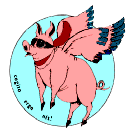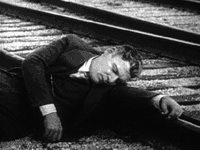| The Journal of Provincial Thought |
|
 |
|||||||||||
| MODEL TRAINS by Lionel R.R. Gilbert |
||||||||||||
 |
Author's love affair with trains runs back decades | |||||||||||
|
I was, like most children of my time, fascinated by trains. I lived in a small city on the western route for the great old railroads—Pennsylvania RR, Chesapeake & Ohio (C &O) RR, Baltimore & Ohio (B & O) RR. To our west, these lines crossed or joined other great roads—the My father took me walking past railroad tracks, and he sometimes timed it so we stood while one of the great Pennsy passenger fliers rocketed through town—the Spirit of St. Louis heading west or the Jeffersonian heading east. They had terrific stainless steel diesel engines (Streamlined! Futuristic!) and sleek Budd cars. As they shot through at dawn or dusk, the lights were on in the cars and people profiled against the windows like small vignettes defining the word “travel.” They were headed beyond the blue horizon, while I stayed at home and wondered. On my own, I mooned around freight crossings and watched switch engines hump strings of reefers (refrigerator cars), flatcars, tank cars, gondolas heaped with dusty coal, boxcars built of tongue-and-groove boards or (more recently) of steel sheets riveted together. At the end was always the caboose—the little red crew car with a jaunty stovepipe, a funny cupola or (sometimes) bow windows, a vestibule tacked on the end. It always looked both homey and exotic, oxymoronic, a crude domestic dwelling transported to faraway places every day. This seemed the best of life’s possibilities. Many ancient bits of machinery were still on the rails, nursed through the dire shortages of WWII. Old steam engines that gasped as they worked, ancient switchers too fatigued to pull a long train, wooden cars disintegrating, rusted tankers and flatcars. But new equipment appeared constantly to replace the worn-out—everyone trusted our future would be filled with railroads. Magazine ads depicted long strings of aluminum and steel cars with sky-view cabins and large windows, air conditioned and as comfortable as riding on a featherbed. The engines shown were mighty diesels that no longer blew dirty plumes of black smoke and white steam. They were bullet-like and self-contained, a disappointment: it was no longer possible to examine the intricate architecture of the big steam engines, with their sets of driver wheels, drive rods, pipes, vents and outlets, oil boxes, big shoulder-like pistons, bells on top for sand and steam and water, the cowcatcher in front like a scoop, the big headlight and nickel-plated bell, the whistle on top, calliope-toned to shriek and moan in the night (and knew the words to that song, too). It was no longer possible to stand on a ridge a half-mile away and watch an engine leave a fat cloudbank of smoke behind and over itself as it rhythmically rolled out of town, with all that music going in perfect time and harmony. The new diesels were exciting because powerful, but they were also little different from diesel tractors for semis, stinking vaguely of burnt oil and making only a low roar, not the think-I-can, think-I-can, know-I-can anthem of assurance steamers sang. Everything about railroads was exciting, however—the engineers and crews, water towers and roundhouses in the yards, the crossings with their clanging bells and flashing lights, the roadbed stretching sinuously out across the flat sameness of tedious Indiana and leading to places I only knew from movies or calendar pictures. In early adolescence, I began to fiddle with a small set of electric trains I had gotten for Christmas—an American Flyer (S gauge) set of a Pacific engine, tender and four green Pennsy passenger cars. I much preferred Gilbert’s S gauge to the clumsy, clunky O gauge of Lionel, the premier toy train maker. My trains were smaller and sleeker and ran on (patented) two-rail track, while the Lionel behemoths ran over the old three-rail track that had been around for 50 years. The Lionel trains just didn’t look right: they were too obviously, smugly and self-sufficiently toy-like, not really scale models but big toys for little hands. If I squinted my eyes as my S gauge train ran round its few feet of track, it looked much like a real train at a quarter-mile or so away. I had an implacable need for models to seem “real,” even though they were teeny and simplified versions of “reality.” So I scorned Lionel and Lionel-owners. I slowly expanded my train set—buying bits of rolling stock and a used Atlantic engine. I added a few more feet of slightly more complicated track. The Gilbert stuff looked great as it rolled—it had a puff-puff-puff sound effect geared to the speed, and if you inserted a little oily mixture into the smoke stacks periodically, it puffed bluish smoke in time with the rhythms. This was pretty darn realistic for me, and I even appreciated the slightly burnt, industrial smell of the smoke. Then, through the local hobby shop, I became aware that adults were interested in scale-model railroading—the small HO gauge equipment (there were smaller gauges, but they were as exotic as ships in bottles) available at considerable expense and requiring much expertise (most equipment was built from kits) and a cosmos of auxiliary technology. Some friends began messing with HO kits, and I joined. We found a large unused pantry-storage room at a friend’s house, empty and available as a locus for a “layout,” as hobbyists called it. The track was tiny 2-railed stuff of soft brass that had to be laid in 2-3-foot lengths about the way real track was laid. It had to be bent to shape, joined with plates and spiked down to scale model roadbed, as if we were a Brobdignagian team of gandy dancers. We built a large table of plywood on sawhorses. On it we designed a trial landscape—a flattish bit of Lilliput with a few hills (demands for tunnels), a winding river to be bridged, a small town with a railroad station and yards, a few streets needing level crossings. Making up geography as we went along, we pooled allowances and after-school-job funds to acquire track and rolling stock. Our only engine at first was a little box-like diesel switcher. A half-dozen of us worked on the layout, demanding turns at running the transformer when we had enough track laid to try out the engine. For the better part of a year, we built little buildings, painted green meadows and tan roads on the plywood, made papier-mâché alps, invented blue ponds and rivers, stuck down shrubs and trees of green sponge-rubber, got the track hitched up, switches in place and several alternative rail routes around this tiny county, shire or parish. We strained our eyes painting details on microscopic people, animals, cars, buildings. We found clever artifacts to incorporate: a picture postcard of Pike’s Peak made a swell billboard by the highway, once glued to a little frame, the town grain elevator was covered with tediously-fabricated galvanized iron (tinfoil) squares, the pond floated boats and even ducks (as small as ladybugs). We learned skills like soldering and wiring, mini-metalwork, all the arts of trompe l’oeil. Our world had its sole aim to fool the eye and senses and to induct an observer fully into this land of bibelot or tchotchke. We egged each other on, criticized and helped and hindered. Between the half-dozen of us, we had put together a dozen or so cars, built another engine (a little steam switcher—nobody could get enough money for a full-sized engine), added and built many accessories. Then it was time for school, eleventh grade, and everything faded. The summer’s work idyll seemed an odd dream, and we were scattered in all directions to football, after-school lessons, extra homework in the honors program. The little The dream had been seductive and wholly consuming. For a while I had lived in a land of teeny-weenyness, and like Gulliver back in No other experience was exactly like descending into the mini-world of the railroad layout. You could lay your head close to the track as someone sped a big HO loco—a hefty Mogul engine, maybe—around, hauling a string of bright boxcars (we borrowed stuff and encouraged other kids to run their stock on our domain). For a second it was all real and a little scary, like the old blues lines: “Gonna lay my head on some lonesome railroad line,/And when the train comes through, I’ll yank it back again.” Or you could spend a weekend creating a farm to fill a landscape void—house, barn, fences, water tank, windmill, a herd of Guernseys, a tractor and wagon, trees, crops growing in a field—oats or barley, maybe. It was pristine, perfect, infallible in HO scale—no worms, blights, droughts, tornados, bank foreclosures, no accidents that sheared off limbs, no numbing handwork that left the body worn out in early middle age. My farmers were as happy as Schumann’s, indefatigable, invincible, prosperous and content. A perfect pastoral. The trains chugged in the background, tugged strings of cars through a mountain pass and into a black tunnel, crossed bridges over raging rivers, and with the lights off chuffed through dark night, headlights and passenger cars weakly glimmering. We built and unbuilt, rearranged the landscape as easily and inscrutably as God Almighty. It was a strange kind of power—not through ourselves but through a surrogate world, a world of little people unknown to us but at our mercy. I tried to see from their perspective—a giant face or great grasping hand descending from the sky. Then things are changed—gone, revised, moved. And it was a world with just night and day, no seasons, no weather, a version of The train craze wore away about the time I got my permanent driver’s license, a steady after-school job and a whole set of new consuming interests—mostly travel and music, or travel and music combined, as in running the back roads in search of rhythm and blues joints and black and tan clubs. The little trains faded in imagination, we broke up the pieces of the big layout, and my old S gauge layout moldered in darkness in our basement. I gave away most of my stuff, and I was only slightly stirred by the sound of a far-off train whistle in the deep night or the sight of a big steam train highballing past a grade crossing. In college I met friends who were railroad nuts of another breed. No modelers, they hunted the real thing, hopping freights and riding out west to find routes that still ran the huge mountain steam locos over the |
||||||||||||
|
||||||||||||
| Copyright 2009- WJ Schafer & WC Smith - All Rights Reserved | ||||||||||||